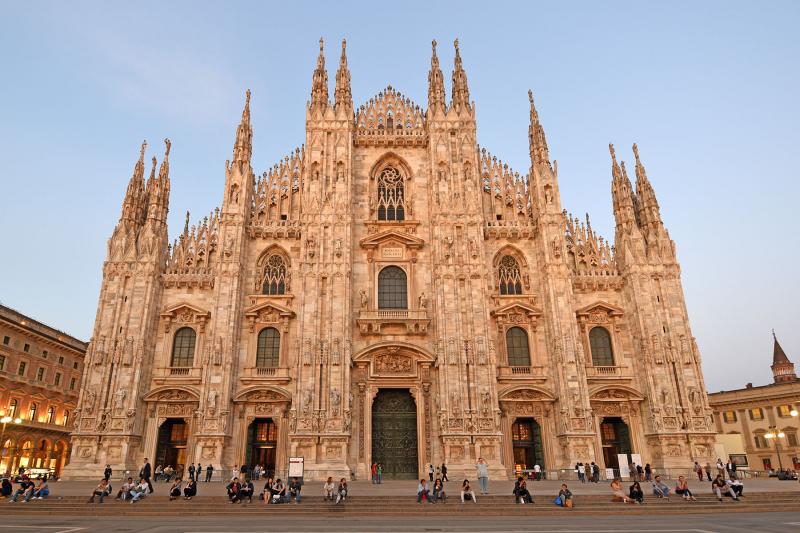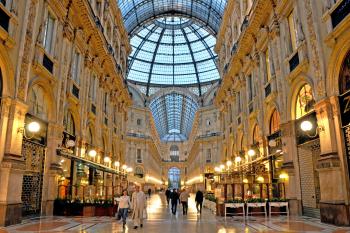Historic hits in Italy's most mod city
Appears in the Online Edition, May 2019.
While many tourists come to Italy only for the past, those who make time for Milan find that this powerful, no-nonsense city is a delightful mix of yesterday and today. Anchored by its historic cathedral, Milan is a modern, time-is-money metropolis of refined tastes. The window displays on its shopping streets are gorgeous, the well-dressed Milanesi are ultra-chic, and even the cheese comes gift-wrapped.
But beyond the bling, Milan has historic highlights as powerful as other Italian cities. A visit to its statue-studded cathedral (the Duomo), with its rooftop overlooking the city, is a one-of-a-kind experience. Nearby is the Galleria, an elegant shopping arcade built in the 1800s but just as lively today. La Scala Opera House is ground zero for the world of opera. And Milan claims one of the Renaissance's top masterpieces, Leonardo da Vinci's The Last Supper.
I like to start a visit in the center of Milan, dominated by the Duomo. It's the third-largest church in Europe, after St. Peter's in Rome and the Cathedral of Sevilla in Spain. To build it, the Milanesi used the most expensive stone they could find -- pink marble.
The facade is a commotion of Gothic features -- pointed-arch windows, statues, little pinnacles, and reliefs. Scholars count a thousand individual carvings -- big and small -- on the church exterior and another two thousand sculptural elements inside. Once you step through the entrance, you're struck by the immensity of the place. The soaring ceiling is supported by sequoia-size pillars.
After touring the interior, you can climb the stairs -- or take an elevator -- to the marble-paved roof, 20 stories up, for the most memorable part of a Duomo visit. Up here, wandering through a fancy forest of spires, you'll notice that the saint statues up close suddenly become more lifelike. Beyond the statues lies a stunning view: On a clear day you can see all the way to the Alps. A 15-foot-tall gilded statue of Virgin Mary on the tallest spire overlooks it all.
Back on the ground, one side of the cathedral is dominated by a grand arch -- the entrance to the Galleria Vittorio Emanuele II -- built as one of the first shopping malls in the world. Then as now, it was home to shops and cafés and lots of strolling locals. Today, you can linger among luxury stores such as Gucci, Louis Vuitton, and Prada.
Though it looks like it's built of stone, the Galleria is actually a skeleton of iron beams, faced with stone, and topped with glass. When it was built, it was the marvel of its day and proclaimed Milan as the most cultured city of a newly united Italian nation. Later, the Galleria was the first building in Milan to have electric lighting.
If you cut through the Galleria from the cathedral square, you'll pop out at Piazza della Scala, home of the La Scala Opera House and Museum. Teatro alla Scala first opened its doors in 1778 and quickly established itself as one of the premier opera theaters in Europe. The stage is enormous, the acoustics are wonderful, and the talent has always been top-notch. Many of the greatest operas got their first performance here -- Madame Butterfly, Nabucco, Turandot. Almost all of the great opera singers -- from Caruso to Callas and Pavarotti -- have sung here. But unless you have tickets to a performance, you'll be limited to the adjacent museum. The main reason to visit the museum is the opportunity (on most days) to peek into the actual theater.
Milan's most famous sight, The Last Supper, is away from the city center. Decorating the former dining hall of the Church of Santa Maria delle Grazie, this remarkable, exactingly crafted fresco by Leonardo is a masterwork of natural-looking lighting and expressive faces. Reservations are mandatory and should be booked three months in advance.
This famous fresco survives -- just barely -- on a church wall. Christ and his 12 apostles are eating their last meal before Jesus is arrested and executed. Leonardo captured the moment of psychological drama when Jesus says that one of the disciples will betray him. The apostles huddle in stressed-out groups of three, wondering, "Lord, is it I?"
Leonardo spent three years on The Last Supper. It's said that he went whole days without painting a stroke, just staring at the work. Then he'd grab a brush, rush up, flick on a dab of paint ... and go back to staring.
Milan may be overshadowed by Venice and Florence, but no Italian trip is complete without visiting this city. This vibrant and vital melting pot of people, industry, and history is one of the treasures of the wonder that is Italy.
IF YOU VISIT...
SLEEPING: Hotel Spadari, two blocks from the Duomo area, offers 40 rooms with billowing drapes, grand paintings, and designer doors (splurge, www.spadarihotel.com). Antica Locanda Leonardo is just down the street from The Last Supper and has a romantic, Old World vibe (moderate, www.anticalocandaleonardo.com).
EATING: Near the Duomo, Ronchi 78 is a Milan institution for traditional Milanese cuisine (Via San Maurilio 7, www.ronchi78.it). Pizzeria Tradizionale is an affordable favorite of locals in Milan'scanal district (Ripa di Porta Ticinese 7, www.pizzeriatradizionale.com).
GETTING AROUND: Milan's public transit system (www.atm.it) includes a clean and easy Metro; buses and trams fill in the gaps.
TOURIST INFORMATION: www.turismo.milano.it.
(Rick Steves (www.ricksteves.com) writes European travel guidebooks and hosts travel shows on public television and public radio. Email him at rick@ricksteves.com and follow his blog on Facebook.)


